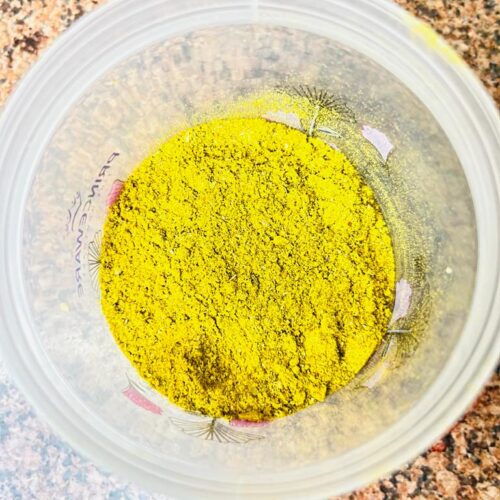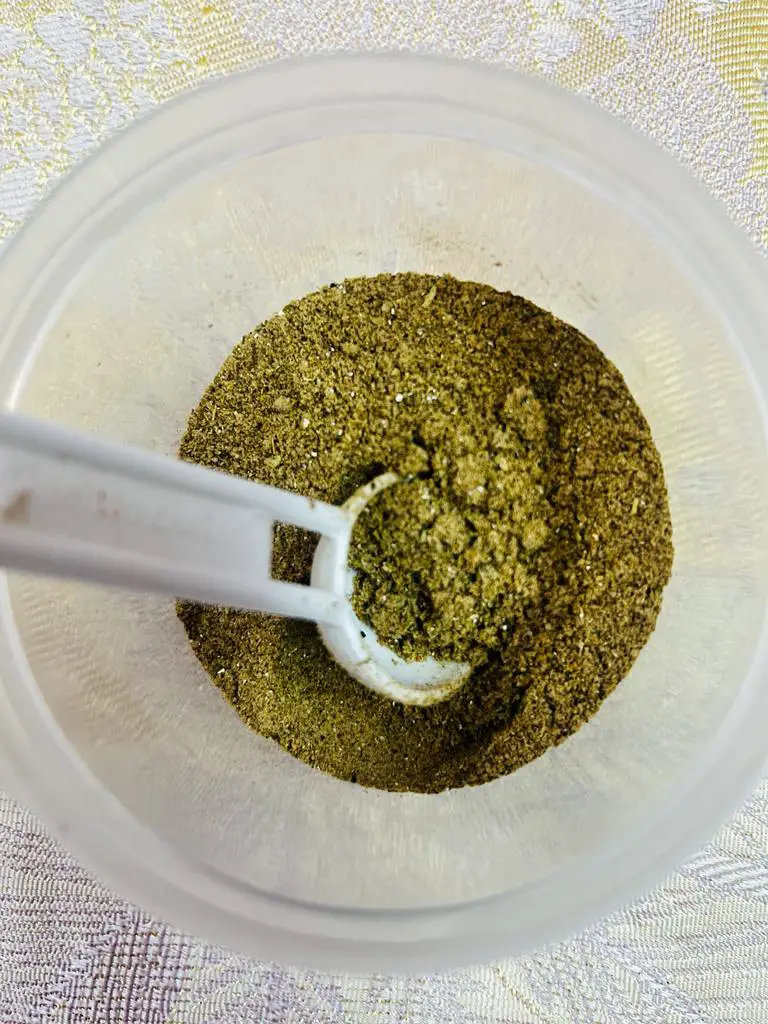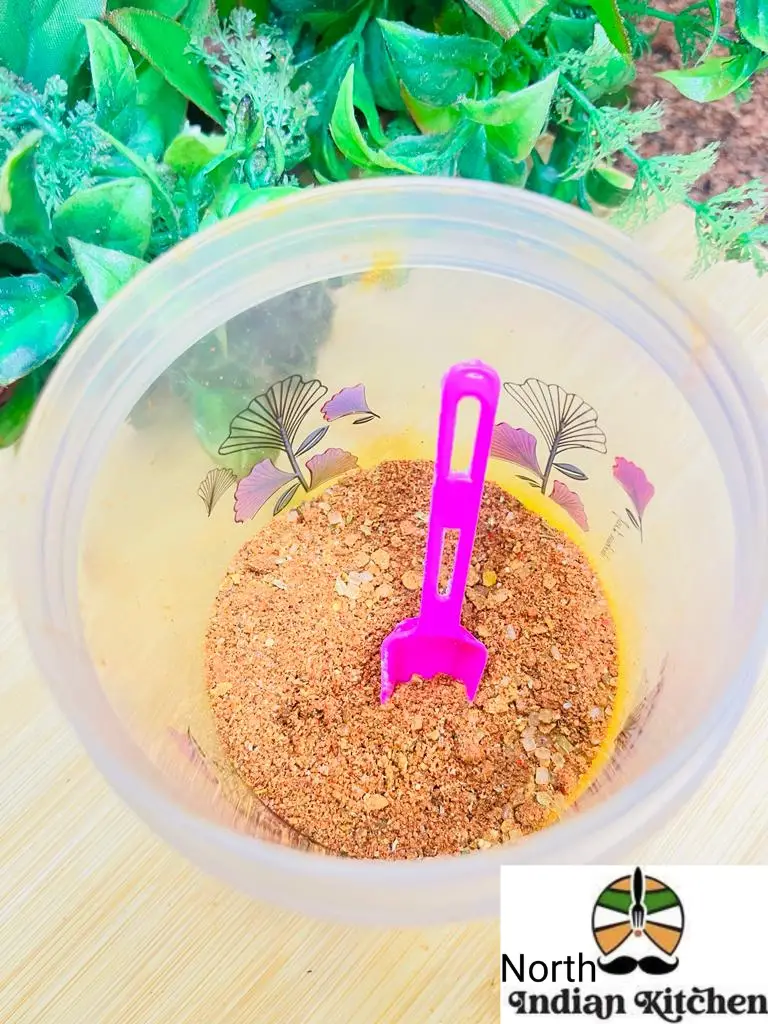How to make Pav Bhaji Masala at Home | Easy Pav Bhaji Masala Recipe
About Pav Bhaji Masala
Pav bhaji masala is a popular spice blend used in Indian cuisine, particularly in the preparation of a popular street food dish called “Pav Bhaji.” Pav bhaji is a delicious and flavorful dish consisting of a spicy vegetable curry (bhaji) served with buttered and toasted bread rolls (pav). The masala, or spice mix, is a key component that adds a distinct and aromatic flavor to the dish.
The pav bhaji masala typically consists of a blend of various ground spices and herbs, carefully combined to create a harmonious flavor profile. While different brands and regions may have variations in their recipes, some common ingredients in pav bhaji masala include coriander seeds, cumin seeds, cloves, cinnamon, fennel seeds, black peppercorns, dried red chilies, turmeric, and dried mango powder (amchur). Other spices such as cardamom, nutmeg, and star anise may also be included in some variations.
The spices are dry roasted or lightly toasted to enhance their flavors and release their essential oils. They are then ground together to create a fine powder, which is the pav bhaji masala. This spice blend is added to the bhaji during the cooking process to infuse the dish with its distinct taste and aroma.
The pav bhaji masala adds a rich, spicy, and tangy flavor to the vegetable curry, giving it a unique character. It balances the flavors of the various vegetables used in the dish, providing a delightful taste experience. The masala also lends a vibrant reddish color to the bhaji, making it visually appealing.
Pav bhaji masala is readily available in pre-packaged form in grocery stores, allowing home cooks and chefs to recreate the authentic flavors of pav bhaji easily. It is a versatile spice blend that can also be used in other Indian dishes, such as pulao, biryani, and curries, to enhance their taste and add a touch of complexity.
Whether enjoyed as a street food delicacy or prepared at home, pav bhaji masala is an essential ingredient that adds a burst of flavors to this beloved Indian dish, making it a favorite among food lovers.
The joy of adding your own homemade spice powders to any dish that you are making at home is unmatched. This is the reason I at least try and prepare mine at home. Just like this Pav Bhaji Masala, a spice mix that is essential for the famous Mumbai street food special recipe of Pav Bhaji. With this amazing Pav Bhaji Masala recipe, you’ll be able to make this spice mix easily at home.
More About Pav Bhaji Masala
Homemade vs. Store-Bought: While pav bhaji masala is readily available in stores, some people prefer making their own homemade version for a more personalized flavor. Homemade masala allows you to adjust the spice levels and experiment with different proportions of spices according to your taste preferences.
Regional Variations: Different regions in India have their own variations of pav bhaji masala. For example, Maharashtrian pav bhaji masala may include additional spices like dagad phool (stone flower) or star anise, while the Punjabi version might have a stronger presence of garam masala.
Key Ingredients and Flavor Profile: The combination of spices in pav bhaji masala creates a unique flavor profile. Coriander seeds and cumin seeds form the base, providing a warm and earthy taste. Other spices like cloves, cinnamon, and black peppercorns add depth and warmth, while dried red chilies bring a hint of spiciness. Turmeric provides color, and dried mango powder (amchur) adds a tangy and slightly sour note.
Usage: Pav bhaji masala is primarily used in the preparation of pav bhaji, where it is added to the vegetable mixture during the cooking process. However, it can also be used to enhance the flavor of other dishes such as masala pulao, vegetable curries, or even as a seasoning for roasted vegetables.
Versatility: Apart from its traditional use in pav bhaji, the masala can be a versatile addition to your spice collection. It can be used as a flavor enhancer in various vegetarian and vegan dishes, adding a punch of taste to lentils, soups, stews, and even snacks like roasted chickpeas or popcorn.
Shelf Life and Storage: Like other spice blends, pav bhaji masala has a shelf life. Store-bought masala typically has a longer shelf life due to the inclusion of preservatives. Homemade masala should be stored in an airtight container in a cool, dark place to maintain its flavor and potency.
Remember, the proportions and ingredients in pav bhaji masala can vary based on personal preference, regional variations, and the brand you choose. Exploring different versions and finding the one that suits your taste is part of the culinary journey. Enjoy the rich and flavorful experience of pav bhaji with this iconic spice blend! Once this masala has been made, store it and further it can be used in Mumbai style Pav Bhaji and Vegetable Pulao .

Before You Begin
This Pav Bhaji Masala recipe is fairly simple and requires not much efforts. These following suggestions are going to help you further:
Check Spices: When working with the spices, check whether there are any stones in them. They have to be perfectly clean with no hidden mold in them, for a good quality homemade Pav Bhaji Masala.
Freshness of Spices: The spices also have to be fresh. Don’t even think of using stale old ones.
Cinnamon type: Remember especially while using cinnamon; you have to use the true Ceylon cinnamon and not the cassia variant. Read up about these on the web before starting with the recipe.
Dry red chillies: I have here used moderately hot red chillies that are not very spicy or hot. Feel free to reduce the red chillies or use the variety of red chillies that are less spicy like Kashmiri red chillies . These will also give a nice orange or red color to the spice mix. You could also swap red chillies with kashmiri red chilli powder.
Usage: Since this Pav Bhaji Masala is robust, it’s better to add just 2 to 3 teaspoons while making a bhaji for 4 to 5 servings.
The Spices should Dry
You will have to dry the spices used in this Pav Bhaji Masala recipe either in the sun or by roasting them in a pan or oven. Whichever way is feasible for you.
I usually sun dry spices when making other spice blends like Garam Masala or Sambar Powder as well. For this Pav Bhaji Masala, you can sundry the spices for 2 to 3 days. Next, use a dry grinder to grind the dried spices to a fine powder. Then, bottle and store.
For times when there’s a dearth of sunlight, roasting the spices is a good idea. Do it one by one in the pan till aromatic. Set aside to cool and then grind to a fine texture.
How to make Pav Bhaji Masala
Prep the Spices:
- Clean and dry all the whole spices properly before starting.
- Remove any dirt or impurities from the spices.
Dry Roasting:
- Heat a pan or skillet over medium heat.
- Add the coriander seeds, cumin seeds, cloves, cinnamon stick, fennel seeds, and dried red chilies to the pan.

- Dry roast the spices for a few minutes, stirring continuously, until they become fragrant. Be careful not to burn them.
- Once roasted, transfer the spices to a plate and let them cool completely.

Grinding the Spices:
- Once the roasted spices are cool, transfer them to a spice grinder, coffee grinder, or mortar and pestle.
- Now add all the whole spices in the dry grinder jar. You can also use a coffee grinder . Add according to the capacity of the jar.

- Grind the spices into a fine powder. If using a grinder, pulse the spices in short bursts until you achieve the desired consistency.
- Then , add 1 tablespoon dried ginger powder (saunth)
- Next, add 2tablespoons dried mango powder(amchur powder)
- Now, add 1 teaspoons black salt. If you do not have black salt, then you can add edible rock salt or regular salt. You can even skip adding salt.
- Lastly ,add 1 teaspoon turmeric powder Turmeric powder is optional and you can skip it too.
- Grind or mix everything together again to ensure that all the ingredients are well combined.

Storing the Masala:
- Transfer the freshly ground pav bhaji masala to an airtight container.

- Store it in a cool, dark place away from moisture and direct sunlight.
- Label the container with the date of preparation for reference.
Your homemade pav bhaji masala is now ready to be used in various dishes, especially in pav bhaji. Adjust the quantities of spices according to your taste preferences and enjoy the authentic flavors it brings to your cooking!
Note: If you don’t have access to sun drying, you can skip that step and proceed with dry roasting the spices on a stovetop as mentioned above. Sun drying is an optional step that helps remove any moisture from the spices and intensifies their flavors.
Expert tips
Quality of Spices: Always use fresh and high-quality spices for the best flavor. Buying whole spices and grinding them yourself ensures maximum freshness and aroma.
Sun Drying (Optional): If you choose to sun dry the spices, ensure that you place them in a clean and dry spot with ample sunlight. Keep an eye on the weather conditions and make sure the spices are fully dried before grinding.
Spice Blending: Grind the roasted spices to a fine powder for a smooth and well-blended masala. If using a coffee grinder, clean it thoroughly to avoid any residual flavors from previous use.
Adjusting Spice Levels: Feel free to adjust the quantity of spices according to your taste preferences. If you prefer a spicier masala, increase the number of dried red chilies or black peppercorns. Similarly, reduce the quantities for a milder version.
Experimentation: While the traditional recipe calls for specific spices, don’t be afraid to experiment with additional spices like cardamom, nutmeg, or star anise to create your own unique masala blend.
Storage and Shelf Life: Store the pav bhaji masala in an airtight container in a cool, dark place. This will help retain its freshness and flavor. It is recommended to consume the masala within 3-6 months for optimal taste.
Multi-purpose Masala: Pav bhaji masala is not limited to pav bhaji alone. Explore using it in other dishes like vegetable curries, pulao, or even as a seasoning for snacks to add a burst of flavor.
Personalize the Masala: The beauty of homemade masala is that you can customize it to your liking. Adjust the spice ratios, experiment with different proportions, and note down the variations that suit your palate the best.
Enjoy the Process: Making pav bhaji masala from scratch can be a delightful culinary experience. Enjoy the aroma of the spices, savor the process, and have fun creating your own signature masala blend.
Remember, practice makes perfect, so don’t be discouraged if your first attempt isn’t exactly as expected. With time and experimentation, you’ll develop your own mastery in creating the perfect pav bhaji masala.
FAQs
Q1: Can I use store-bought pav bhaji masala instead of making it at home?
A1: Yes, you can use store-bought pav bhaji masala as a convenient alternative. However, making your own masala allows you to customize the flavors and adjust the spice levels according to your preference.
Q2: Can I use pav bhaji masala in other dishes?
A2: Yes, pav bhaji masala can be used in other dishes like vegetable curries, pulao, or as a seasoning for roasted vegetables. It adds a unique and flavorful twist to various recipes.
Q3: Can I substitute any spices in pav bhaji masala?
A3: While it’s best to stick to the traditional spice blend, you can experiment with variations based on your taste. Just keep in mind that substitutions may alter the authentic flavor of the masala.
Q4: How long can I store pav bhaji masala?
A4: When stored in an airtight container in a cool, dark place, homemade pav bhaji masala can retain its flavor for around 3-6 months. However, it’s best to consume it within the first few months for optimal taste.
Q5: What if I can’t find some of the spices listed in the recipe?
A5: If you can’t find certain spices, you can try substituting them with similar spices that you have on hand. For example, you can replace dried red chilies with red chili powder or paprika. Adjust the quantities accordingly to maintain the desired flavor.
Q6: Can I make a larger batch of pav bhaji masala?
A6: Yes, you can scale up the recipe to make a larger batch of pav bhaji masala. Just ensure that you maintain the proper proportions of the spices to maintain the balance of flavors.
Q7: How spicy is pav bhaji masala?
A7: The spiciness of pav bhaji masala can vary depending on the quantity of dried red chilies and black peppercorns used. It is typically moderately spicy, but you can adjust the spice levels to your liking.
Q8: Can I use pav bhaji masala in non-vegetarian dishes?
A8: While pav bhaji masala is traditionally used in vegetarian dishes, you can certainly experiment with it in non-vegetarian recipes. It may add a unique flavor profile to certain meat or seafood dishes.
If you like this recipe then try our Other Spice Recipes
Please be sure to rate this recipe or leave a comment below if you have made it. For more veetarian inspirations, Sign Up for my emails or follow me on Instagram, Youtube, Facebook , Twitter or Pinterest.
Pav Bhaji Masala Recipe Card
Equipments
Ingredients
- 5 tablespoon Coriander seeds
- 3 tablespoon Cumin seeds
- 22 piece Cloves
- 5 piece Star anise
- 6 piece Black Cardamom
- 4 Sticks Cinnamon
- 5 Piece Bay leaf
- 20 pieces Kashmiri red chili
- 3 tablespoon Fennel Seeds
- 2 tablespoon Kasuri methi
- ½ teaspoon Turmeric powder
- ½ teaspoon Ginger powder (dry)
- 1 teaspoon Hing
- 1 teaspoon Black salt
- 1 tablespoon Aamchur powder
- 1 tablespoon Salt
Instructions
- Prep the Spices: Clean and dry all the whole spices properly before starting. Remove any dirt or impurities from the spices. Dry Roasting: 2. Heat a pan or skillet over medium heat. Add the coriander seeds, cumin seeds, cloves, cinnamon stick, fennel seeds, and dried red chilies to the pan.3. Dry roast the spices for a few minutes, stirring continuously, until they become fragrant. Be careful not to burn them.4. Once roasted, transfer the spices to a plate and let them cool completely.Grinding the Spices: 5. Once the roasted spices are cool, transfer them to a spice grinder, coffee grinder, or mortar and pestle.6. Now add all the whole spices in the dry grinder jar. You can also use a coffee grinder . Add according to the capacity of the jar.7. Grind the spices into a fine powder. If using a grinder, pulse the spices in short bursts until you achieve the desired consistency.8. Then , add 1 tablespoon dried ginger powder (saunth), 2tablespoonsdried mango powder(amchur powder)9. Next, add 1 teaspoons black salt. If you do not have black salt, then you can add edible rock salt or regular salt. You can even skip adding salt.10. Lastly ,add 1 teaspoon turmeric powder Turmeric powder is optional and you can skip it too.11. Grind or mix everything together again to ensure that all the ingredients are well combined.12. Transfer the freshly ground pav bhaji masala to an airtight container.Your Pav Bhaji masala is Ready
Video
Notes
- Dry roasting the spices enhances their flavors. Take care not to burn them and let them cool before grinding. Grind the spices into a fine powder for a smooth and well-blended masala.
- Store the pav bhaji masala in an airtight container in a cool, dark place. This helps preserve its freshness and flavor. Label the container with the date of preparation for reference.









Too simple and easy recipe.
Thanks for your feedback. We are very glad that you like our recipes.